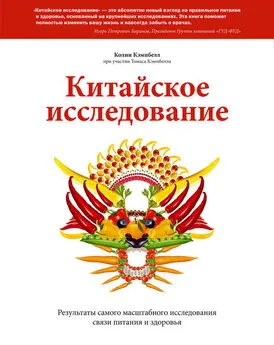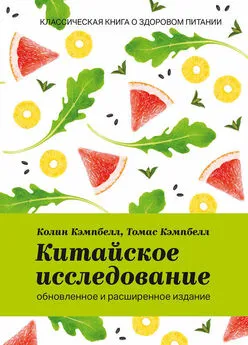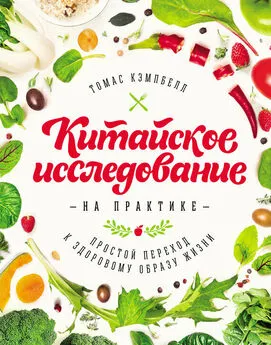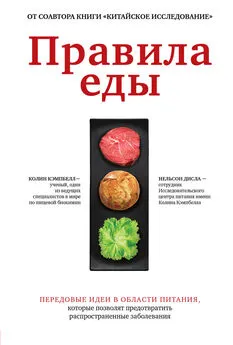Колин Кэмпбелл - Китайское исследование: обновленное и расширенное издание. Классическая книга о здоровом питании [litres]
- Название:Китайское исследование: обновленное и расширенное издание. Классическая книга о здоровом питании [litres]
- Автор:
- Жанр:
- Издательство:Литагент МИФ без БК
- Год:2018
- Город:Москва
- ISBN:978-5-00100-976-4
- Рейтинг:
- Избранное:Добавить в избранное
-
Отзывы:
-
Ваша оценка:
Колин Кэмпбелл - Китайское исследование: обновленное и расширенное издание. Классическая книга о здоровом питании [litres] краткое содержание
На русском языке публикуется впервые.
Китайское исследование: обновленное и расширенное издание. Классическая книга о здоровом питании [litres] - читать онлайн бесплатно ознакомительный отрывок
Интервал:
Закладка:
1194
Vegetarian Resource Group. “How Many Vegetarians Are There?” март 2004 г. На сайте www.vrg.org/journal/vj2003issue3/vj2003issue3poll.htm.
1195
Herman-Cohen V. “Vegan revolution.” Ithaca Journal (reprinted from LA Times), 11 августа 2003 г.: 12A.
1196
Sabate J., Duk A., and Lee C. L. “Publication trends of vegetarian nutrition articles in biomedical literature, 1966–1995.” Am. J. Clin. Nutr. 70 (Suppl) (1999): 601S–607S.
1197
Boyd J. N., Misslbeck N., Parker R. S., et al. “Sucrose enhanced emergence of aflatoxin B1 (AFB1) induced GGt positive rat hepatic cell foci.” Fed. Proc. 41 (1982): 356 Abst.
1198
Tannenbaum A., and Silverstone H. “Nutrition in relation to cancer.” Adv. Cancer Res. 1 (1953): 451–501.
1199
Youngman L. D. The growth and development of aflatoxin B1-induced preneoplastic lesions, tumors, metastasis, and spontaneous tumors as they are influenced by dietary protein level, type, and intervention. Ithaca, NY: Cornell University (диссертация на соискание докторской степени), 1990.
1200
Youngman L. D., and Campbell T. C. “Inhibition of aflatoxin B1-induced gamma-glutamyl transpeptidase positive (GGT+) hepatic preneoplastic foci and tumors by low protein diets: evidence that altered GGT+ foci indicate neoplastic potential.” Carcinogenesis 13 (1992): 1607–1613.
1201
Horio F., Youngman L. D., Bell R. C., et al. “Thermogenesis, low-protein diets, and decreased development of AFB1-induced preneoplastic foci in rat liver.” Nutr. Cancer 16 (1991): 31–41.
1202
Bell R. C., Levitsky D. A., and Campbell T. C. “Enhanced thermogenesis and reduced growth rates do not inhibit GGT+ hepatic preneoplastic foci development.” FASEB J. 6 (1992): 1395 Abs.
1203
Miller D. S., and Payne P. R. “Weight maintenance and food intake.” J. Nutr. 78 (1962): 255–262.
1204
Stirling J. L., and Stock M. J. “Metabolic origins of thermogenesis by diet.” Nature 220 (1968): 801–801.
1205
Donald P., Pitts G. C., and Pohl S. L. “Body weight and composition in laboratory rats: effects of diets with high or low protein concentrations.” Science 211 (1981): 185–186.
1206
Rothwell N. J., Stock M. J., and Tyzbir R. S. “Mechanisms of thermogenesis induced by low protein diets.” Metabolism 32 (1983): 257–261.
1207
Rothwell N. J., and Stock M. J. “Influence of carbohydrate and fat intake on diet-induced thermogenesis and brown fat activity in rats fed low protein diets.” J. Nutr. 117 (1987): 1721–1726.
1208
Krieger E., Youngman L. D., and Campbell T. C. “The modulation of aflatoxin (AFB1) induced preneoplastic lesions by dietary protein and voluntary exercise in Fischer 344 rats.” FASEB J. 2 (1988): 3304 Abs.
1209
Chen J., Campbell T. C., Li J., et al. Diet, Life-style and Mortality in China. A Study of the Characteristics of 65 Chinese Counties. Oxford, UK; Ithaca, NY; Beijing, PRC: Oxford University Press; Cornell University Press; People’s Medical Publishing House, 1990.
1210
Chen J., Campbell T. C., Li J., et al. Diet, Life-style and Mortality in China. A Study of the Characteristics of 65 Chinese Counties. Oxford, UK; Ithaca, NY; Beijing, PRC: Oxford University Press; Cornell University Press; People’s Medical Publishing House, 1990.
1211
Chen J., Campbell T. C., Li J., et al. Diet, Life-style and Mortality in China. A Study of the Characteristics of 65 Chinese Counties. Oxford, UK; Ithaca, NY; Beijing, PRC: Oxford University Press; Cornell University Press; People’s Medical Publishing House, 1990.
1212
Уровень смертности составлял 82, но примерно треть случаев одного и того же заболевания повторялась у людей другого возраста.
1213
Это также означает, что очень мало или совсем нет полезных данных при включении показателей всех людей в округе. Есть только один показатель заболевания для каждого округа; при этом необходимо иметь только один показатель для любой из переменных для сопоставления с индикатором заболеваемости.
1214
Piazza A. Food Consumption and Nutritional Status in the People’s Republic of China. London: Westview Press, 1986.
1215
Messina M., and Messina V. The Dietitian’s Guide to Vegetarian Diets. Issues and Applications. Gaithersburg, MD: Aspen Publishers, Inc., 1996.
1216
Chen J., Campbell T. C., Li J., et al. Diet, Life-style and Mortality in China. A Study of the Characteristics of 65 Chinese Counties. Oxford, UK; Ithaca, NY; Beijing, PRC: Oxford University Press; Cornell University Press; People’s Medical Publishing House, 1990.
1217
Holick M. F. В: M. E. Shils, J. A. Olson, M. Shike, and A. C. Ross (eds.). Modern Nutrition in Health and Disease, 9-е издание, 329–345. Baltimore: Williams and Wilkins, 1999.
1218
Barger-Lux M. J., Heaney R., Dowell S., et al. “Vitamin D and its major metabolites: serum levels after graded oral dosing in healthy men.” Osteoporosis Int. 8 (1998): 222–230.
1219
Биологический период полувыведения витамина D составляет 10–19 дней, то есть за это время он теряет половину своей силы.
1220
Colston K. W., Berger U., and Coombes R. C. “Possible role for vitamin D in controlling breast cancer cell proliferation.” Lancet 1 (1989): 188–191.
1221
Nieves J., Cosman F., Herbert J., et al. “High prevalence of vitamin D deficiency and reduced bone mass in multiple sclerosis.” Neurology 44 (1994): 1687–1692.
1222
Al-Qadreh A., Voskaki I., Kassiou C., et al. “Treatment of osteopenia in children with insulin-dependent diabetes mellitus: the effect of 1-alpha hydroxyvitamin D3.” Eur. J. Pediatr. 155 (1996): 15–17.
1223
Cantorna M. T., Hayes C. E., and DeLuca H.F. “1,25-Dihydroxyvitamin D3 reversibly blocks the progression of relapsing encephalomyelitis, a model of multiple sclerosis.” Proc. National Acad. Sci. 93 (1996): 7861–7864.
1224
Rozen F., Yang X.-F., Huynh H., et al. “Antiproliferative action of vitamin D-related compounds and insulin-like growth factor-binding protein 5 accumulation.” J. Nat. Cancer Inst. 89 (1997): 652–656.
1225
Cosman F., Nieves J., Komar L., et al. “Fracture history and bone loss in patients with MS.” Neurology 51 (1998): 1161–1165.
1226
Giovannucci E., Rimm E., Wolk A., et al. “Calcium and fructose intake in relation to risk of prostate cancer.” Cancer Res. 58 (1998): 442–447.
1227
Peehl D. M., Krishnan A. V., and Feldman D. “Pathways mediating the growth-inhibitory action of vitamin D in prostate cancer.” J. Nutr. 133 (Suppl) (2003): 2461S–2469S.
1228
Zella J. B., McCary L. C., and DeLuca H. F. “Oral administration of 1,25-dihydroxyvitamin D3 completely protects NOD mice from insulin-dependent diabetes mellitus.” Arch. Biochem Biophys. 417 (2003): 77–80.
1229
Davenport C. B. “Multiple sclerosis from the standpoint of geographic distribution and race.” Arch. Neurol. Psychiatry 8 (1922): 51–58.
1230
Alter M., Yamoor M., and Harshe M. “Multiple sclerosis and nutrition.” Arch. Neurol. 31 (1974): 267–272.
1231
Van der Mei I. A, Ponsonby A. L., Blizzard L., et al. “Regional variation in multiple sclerosis prevalence in Australia and its association with ambivalent ultraviolet radiation.” Neuroepidemiology 20 (2001): 168–174.
1232
McLeod J. G., Hammond S. R., and Hallpike J. F. “Epidemiology of multiple sclerosis in Australia. With NSW and SA survey results.” Med. J. Austr. 160 (1994): 117–122.
1233
Holick M. F. “Vitamin D: a millennium perspective.” J. Cell. Biochem. 88 (2003): 296–307.
1234
Holick M. F. “Vitamin D: a millennium perspective.” J. Cell. Biochem. 88 (2003): 296–307.
1235
MacLaughlin J. A., Gange W., Taylor D., et al. “Cultured psoriatic fibroblasts from involved and uninvolved sites have a partial, but not absolute resistance to the proliferation-inhibtion activity of 1,25-dihydroxyvitamin Ds.” Proc. National Acad. Sci. 52 (1985): 5409–5412.
1236
Goldberg P., Fleming M. C., and Picard E. H. “Multiple sclerosis: decreased relapse rate through dietary supplementation with calcium, magnesium and vitamin D.” Med. Hypoth. 21 (1986): 193–200.
1237
Andjelkovic Z., Vojinovic J., Pejnovic N., et al. “Disease modifying and immunomodulatory effects of high dose 1a(OH)D3 in rheumatoid arthritis patients.” Clin. Exp. Rheumatol. 17 (1999): 453–456.
1238
Hypponen E., Laara E., Reunanen A., et al. “Intake of vitamin D and risk of Type 1 diabetes: a birth-cohort study.” Lancet 358 (2001): 1500–1503.
1239
Breslau N.A., Brinkley L., Hill K. D., et al. “Relationship of animal protein-rich diet to kidney stone formation and calcium metabolism.” J. Clin. Endocrinol. Metab. 66 (1988): 140–146.
1240
Langman C. B. “Calcitriol metabolism during chronic metabolic acidosis.” Semin. Nephrol. 9 (1989): 65–71.
1241
Giovannucci E., Rimm E., Wolk A., et al. “Calcium and fructose intake in relation to risk of prostate cancer.” Cancer Res. 58 (1998): 442–447.
1242
Chan J. M., Giovannucci E. L., Andersson S.-O., et al. “Dairy products, calcium, phosphorus, vitamin D, and risk of prostate cancer (Sweden).” Cancer Causes and Control 9 (1998): 559–566.
1243
Holick M. F. В: M. E. Shils, J. A. Olson, M. Shike, and A. C. Ross (eds.). Modern Nutrition in Health and Disease, 9-е издание, 329–345. Baltimore: Williams and Wilkins, 1999.
1244
Byrne P. M., Freaney R., and McKenna M. J. “Vitamin D supplementation in the elderly: review of safety and effectiveness of different regimes.” Calcified Tissue Int. 56 (1995): 518–520.
1245
Agranoff B. W., and Goldberg D. “Diet and the geographical distribution of multiple sclerosis.” Lancet 2 (2 ноября 1974 г.): 1061–1066.
Читать дальшеИнтервал:
Закладка:
![Обложка книги Колин Кэмпбелл - Китайское исследование: обновленное и расширенное издание. Классическая книга о здоровом питании [litres]](/books/1059662/kolin-kempbell-kitajskoe-issledovanie-obnovlennoe.webp)









